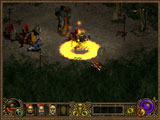 As anyone in the gaming
industry will tell you, it’s difficult to capture lightning in a bottle, but every
once in a while someone manages to do it. Blizzard, for instance, managed to put together
a near-perfect gaming experience with Diablo and Diablo II—not too hard, just deep
enough, nice balance of all-out clickfest action and RPG-lite exercises in stats and
equipment management. Sierra’s Throne of Darkness has many of the same elements as
Diablo—hell, its development team is made up in part by members of the original
Diablo team—but it attempts to overgo Diablo by allowing you to "control"
up to seven different characters (and up to four at any one time). While this might have
seemed like a good idea at one time—"Hey, let’s make a game just like
Diablo, but with, like, seven characters under the player’s control! That means
it’ll be, like, seven times better!" this sort of calculus just doesn’t
work out in Throne of Darkness, partly because a clumsy interface makes exchanging items
and managing characters an irritating exercise in tedium, partly because there just
isn’t that much character in any of these characters, partly because rabid friendly
AI frustrates any attempt to implement the sophisticated group tactics the game’s
manual suggests are a large part of the game. In the end, Throne of Darkness is a
Diabloesque hack n’ slash punctuated by large periods of increasingly tiresome
item-shuffling and character maintenance.
As anyone in the gaming
industry will tell you, it’s difficult to capture lightning in a bottle, but every
once in a while someone manages to do it. Blizzard, for instance, managed to put together
a near-perfect gaming experience with Diablo and Diablo II—not too hard, just deep
enough, nice balance of all-out clickfest action and RPG-lite exercises in stats and
equipment management. Sierra’s Throne of Darkness has many of the same elements as
Diablo—hell, its development team is made up in part by members of the original
Diablo team—but it attempts to overgo Diablo by allowing you to "control"
up to seven different characters (and up to four at any one time). While this might have
seemed like a good idea at one time—"Hey, let’s make a game just like
Diablo, but with, like, seven characters under the player’s control! That means
it’ll be, like, seven times better!" this sort of calculus just doesn’t
work out in Throne of Darkness, partly because a clumsy interface makes exchanging items
and managing characters an irritating exercise in tedium, partly because there just
isn’t that much character in any of these characters, partly because rabid friendly
AI frustrates any attempt to implement the sophisticated group tactics the game’s
manual suggests are a large part of the game. In the end, Throne of Darkness is a
Diabloesque hack n’ slash punctuated by large periods of increasingly tiresome
item-shuffling and character maintenance. 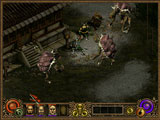 The biggest perk ToD has is
its mythological/samurai Japanese setting. There’s an obligatory backstory about you
being a Daimyo tasked with ridding your country of the demon Zanshin, which will require
you to hack through his innumerable minions before facing down the demon
himself—wait, where have I heard this one before? While you putatively play the role
of the Daimyo, that really means you control seven different samuari—the leader, who
has high charisma and gets great deals from the game’s merchants; the brick, your
hulking tank character, the berserker, the swordsman, the wizard, the ninja, and the
archer. You can only control four of the seven samurai at any time, which becomes a
problem when you begin to level up—often your most active samurai will become
stronger and capable of fighting at levels much higher than the ones you find less useful.
What this means, of course, is that you’ll probably end up using the same 4 or 5
samurai for most of the game, and the others will become increasingly superfluous as the
game proceeds.
The biggest perk ToD has is
its mythological/samurai Japanese setting. There’s an obligatory backstory about you
being a Daimyo tasked with ridding your country of the demon Zanshin, which will require
you to hack through his innumerable minions before facing down the demon
himself—wait, where have I heard this one before? While you putatively play the role
of the Daimyo, that really means you control seven different samuari—the leader, who
has high charisma and gets great deals from the game’s merchants; the brick, your
hulking tank character, the berserker, the swordsman, the wizard, the ninja, and the
archer. You can only control four of the seven samurai at any time, which becomes a
problem when you begin to level up—often your most active samurai will become
stronger and capable of fighting at levels much higher than the ones you find less useful.
What this means, of course, is that you’ll probably end up using the same 4 or 5
samurai for most of the game, and the others will become increasingly superfluous as the
game proceeds.
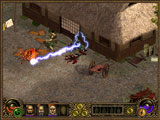 All of the characters have different stats and attributes, but this makes
surprisingly little difference in gameplay. The tank, berserker, and swordsman are melee
troops that play pretty much the same; the ninja, wizard, and archer are ranged troops
that play pretty much the same. There’s nothing like the sort of differentiation you
get between, say, the barbarian and the paladin in Diablo II. Even worse, the ranged
characters need a lot of babysitting, often get killed, and therefore often get left on
the bench. Since you can only control one player at a time, a group with more than one of
these ranged characters can be very difficult to control. That’s because the computer
does a pretty poor job of controlling the others.
All of the characters have different stats and attributes, but this makes
surprisingly little difference in gameplay. The tank, berserker, and swordsman are melee
troops that play pretty much the same; the ninja, wizard, and archer are ranged troops
that play pretty much the same. There’s nothing like the sort of differentiation you
get between, say, the barbarian and the paladin in Diablo II. Even worse, the ranged
characters need a lot of babysitting, often get killed, and therefore often get left on
the bench. Since you can only control one player at a time, a group with more than one of
these ranged characters can be very difficult to control. That’s because the computer
does a pretty poor job of controlling the others.
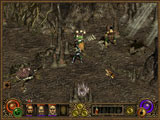 One of the oddest things about Throne of Darkness is that the designers seemed
to want to give the player some sort of control over the other characters in play, because
there are buttons that allow you to access certain "tactics" or formations in
which to deploy your band. Unfortunately, these innovations are largely useless.
Formations are named after animals—stuff like centipede and snake and
tiger—however, there’s not really any intuitive way of knowing what the hell
these formations do, and there seems to be no real correlation between the
formation’s name and its function, which is just silly. Adding to the general level
of bafflement surrounding these tactics, formations don’t automatically adjust their
facings when you move off in a different direction. So if you have a force that has tanks
in front and ranged weapons in back, you’re good so long as you continue to move from
left to right on your screen—however, if you should begin to move top to bottom, or,
god forbid, right to left, your archers will suddenly be screening for your melee guys.
The only way out of this fix is to readjust your formation each time it changes direction,
which is tedious and annoying and inexplicable—could auto-facing have been so
difficult to program? Of course, if you’re really ambitious, you can avail yourself
of the game’s tactics editor, which allows you to adjust the formations according to
your own whims. You can designate what sort of character fills each position in the
formation, what their weapons preferences are, and their general level of aggression.
Unfortunately, the aforementioned facing problem nullifies much of the editor’s
usefulness, and setting a character’s level of aggression doesn’t usually seem
to have much effect on his actual gameplay behavior. One of ToD’s big problems is
that characters not under your control have all the self-discipline of your average Tribes
2 player, so they’ll often run off the screen and into combat—no matter how
preposterously outnumbered—and then they’ll die.
One of the oddest things about Throne of Darkness is that the designers seemed
to want to give the player some sort of control over the other characters in play, because
there are buttons that allow you to access certain "tactics" or formations in
which to deploy your band. Unfortunately, these innovations are largely useless.
Formations are named after animals—stuff like centipede and snake and
tiger—however, there’s not really any intuitive way of knowing what the hell
these formations do, and there seems to be no real correlation between the
formation’s name and its function, which is just silly. Adding to the general level
of bafflement surrounding these tactics, formations don’t automatically adjust their
facings when you move off in a different direction. So if you have a force that has tanks
in front and ranged weapons in back, you’re good so long as you continue to move from
left to right on your screen—however, if you should begin to move top to bottom, or,
god forbid, right to left, your archers will suddenly be screening for your melee guys.
The only way out of this fix is to readjust your formation each time it changes direction,
which is tedious and annoying and inexplicable—could auto-facing have been so
difficult to program? Of course, if you’re really ambitious, you can avail yourself
of the game’s tactics editor, which allows you to adjust the formations according to
your own whims. You can designate what sort of character fills each position in the
formation, what their weapons preferences are, and their general level of aggression.
Unfortunately, the aforementioned facing problem nullifies much of the editor’s
usefulness, and setting a character’s level of aggression doesn’t usually seem
to have much effect on his actual gameplay behavior. One of ToD’s big problems is
that characters not under your control have all the self-discipline of your average Tribes
2 player, so they’ll often run off the screen and into combat—no matter how
preposterously outnumbered—and then they’ll die.
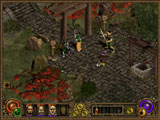 This isn’t actually the gamebreaker it could be, since you can immediately
"teleport" dead samurai back to the Daimyo where they’ll be reincarnated
and restored to health and replaced by one of your three reserve samurai. Unfortunately,
since the guys sitting on the bench are usually stuck at a much lower level than your
first stringers—though enthusiastically sharing their penchant for suicidal
attacks—they’ll seldom last long themselves. In other words, for all the time
that the development team put into the tactics and tactics editor, they’re pretty
much useless, and most players will soon abandon them. That’s the down side. The up
side is that it doesn’t really make any difference, and once you just relax and get
into the game’s frantic and unpremeditated hack and slash spirit, you can do just
fine letting your guys run around like rabid dogs..
This isn’t actually the gamebreaker it could be, since you can immediately
"teleport" dead samurai back to the Daimyo where they’ll be reincarnated
and restored to health and replaced by one of your three reserve samurai. Unfortunately,
since the guys sitting on the bench are usually stuck at a much lower level than your
first stringers—though enthusiastically sharing their penchant for suicidal
attacks—they’ll seldom last long themselves. In other words, for all the time
that the development team put into the tactics and tactics editor, they’re pretty
much useless, and most players will soon abandon them. That’s the down side. The up
side is that it doesn’t really make any difference, and once you just relax and get
into the game’s frantic and unpremeditated hack and slash spirit, you can do just
fine letting your guys run around like rabid dogs..
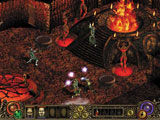 But the absolute worst thing about this game is item management. As in Diablo,
dead monsters leave a lot of stuff lying around on the ground. Weapons, armor, necklaces,
talismans, masks, you name it. Each character has a lot of slots to put this stuff in, and
keeping track of all this haberdashery for seven different characters can be very tedious,
especially since there’s no elegant way to exchange items, and even the game’s
limited supply of gold must be shunted between players in order to make purchases. Items
also wear out very quickly, and you’ll spend an unconscionable amount of time (though
little money) getting items repaired. Which is, after all, what I play a game for. You can
also find stuff you can combine with weapons and armor by accessing the blacksmith or
priest—which, in one of the few unwieldy conventions in the game, can be done at any
time--but it costs money to so, which is in curiously short supply.
But the absolute worst thing about this game is item management. As in Diablo,
dead monsters leave a lot of stuff lying around on the ground. Weapons, armor, necklaces,
talismans, masks, you name it. Each character has a lot of slots to put this stuff in, and
keeping track of all this haberdashery for seven different characters can be very tedious,
especially since there’s no elegant way to exchange items, and even the game’s
limited supply of gold must be shunted between players in order to make purchases. Items
also wear out very quickly, and you’ll spend an unconscionable amount of time (though
little money) getting items repaired. Which is, after all, what I play a game for. You can
also find stuff you can combine with weapons and armor by accessing the blacksmith or
priest—which, in one of the few unwieldy conventions in the game, can be done at any
time--but it costs money to so, which is in curiously short supply.
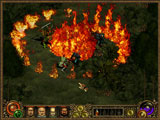 The game’s graphics are OK, but nothing special, and the monsters
you’ll face are pretty predictable and, as in Diablo, often the same with minor
changes in color or appearance. Spells look nice, but they’re much the same for each
character, and the spellcasting system is very clumsy and limited next to, say,
Diablo’s—especially since you can only access one at a time.
The game’s graphics are OK, but nothing special, and the monsters
you’ll face are pretty predictable and, as in Diablo, often the same with minor
changes in color or appearance. Spells look nice, but they’re much the same for each
character, and the spellcasting system is very clumsy and limited next to, say,
Diablo’s—especially since you can only access one at a time.
I’ve been tough on Throne of Darkness, but it’s not a terrible game—just
an average one, and one that falls conspicuously short of its own ambitions.
